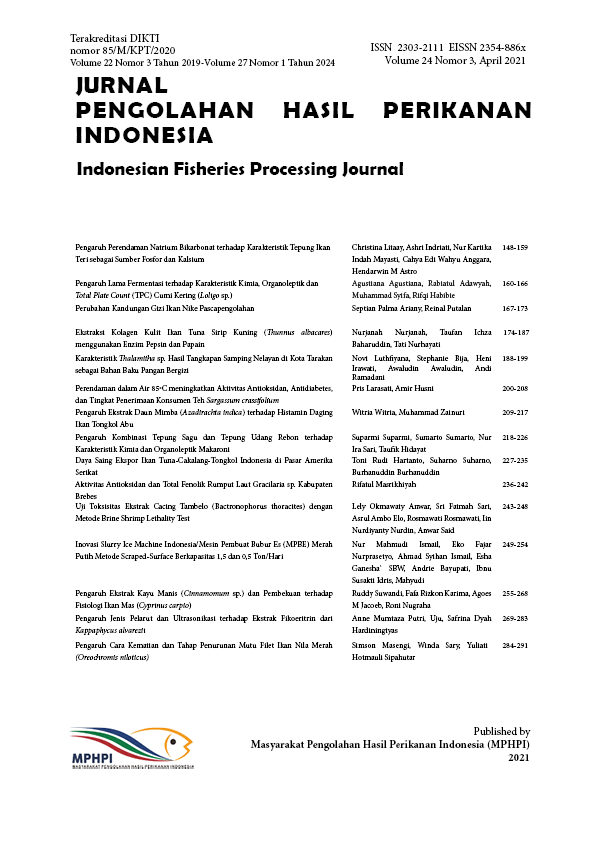Aktivitas Antibakteri Ekstrak Sargassum plagyophyllum terhadap Bakteri Listeria monocytogenes dan Pseudomonas aeruginosa Antibacterial Activity of Sargassum plagyophyllum Extract against Listeria Monocytogenes and Pseudomonas aeruginosa
Abstract
Listeria monocytogenes and Pseudomonas aeruginosa are pathogenic bacteria that must be inhibited and killed using antibacterial compounds. Sargassum sp. is one of the type of brown seaweed which has bioactive compounds as antibacterial. The research was aimed to determine the bioactive compounds and antibacterial activities of Sargassum plagyophyllum extract. This research consisted of maceration and characterization of S. plagyophyllum which included phytochemical screening and gram positive and negative antibacterial analysis at different concentrations of extract (2, 4, and 6% w/v). Methanol extract of S. plagyophyllum had a yield of 1.32±0.04% and contained bioactive compounds such as alkaloids, steroids, saponins, and phenolics. Based on antibacterial activity, S. plagyophyllum extract had the inhibition zone diameter both for gram positive bacteria (L. monocytogenes) and gram negative bacteria (P. aeruginosa), Nevertheless, the inhibition zone diameter of gram negative bacteria (6.67±0.58 mm) was greater than gram positive bacteria (4.67±0.58 mm) at the highest concentration of extract (6%).
References
[WHO] World Health Organization. 2020. Coronavirus disease (COVID-19) Pandemic. https://www.who.int/emergencies/diseases/novel-coronavirus-2019 diakses 23 April 2020.
Andriani Z, Ghanaim F, Ahmad H. 2015. Antibacterial activity of the red Algae
Eucheuma cottonii extract from Tanjung Coast, Sumenep Madura. Alchemy: Journal of Chemistry. 4: 93-100.
Asngad A, Bagas A, dan Novitasari. 2018. Kualitas gel pembersih tangan (hand sanitizer) dari ekstrak batang pisang dengan penambahan alkohol, triklosan, dan gliserin yang berbeda dosisnya. Jurnal Bioeksperimen. 4 (2): 61 – 70.
Bachtiar A. 2007. Penelusuran Sumber Daya Hayati Laut (Alga) Sebagai Biotarget Industri. [Makalah]. Jatinagor (ID): Fakultas Perikanan dan Ilmu Kelautan Universitas Padjadjaran.
Copriyadi J, Yasmi E, Hidayati. 2005. Isolation and characterization of coumarines from peels of orange (Citrus hystrix DC). Jurnal Biogenesis. 2: 13 – 25.
Evy, Yulianti, Anna R. 2017. Screening and characterization of phosphate solubilizing bacteria from isolate of thermophilic bacteria. AIP Conference Proceeding. 1868, 090015.
Hanapi A, Fasya AG, Mardiyah U, dan Miftahurrahmah. 2013. Uji aktivitas antioksidan dan antibakteri ekstrak metanol alga merah Eucheuma spinosum dari Perairan Wongsorejo Banyuwangi. Alchemy. 2 (2): 126 – 137.
Harborne JB. 1987. Metode Fitokimia. Bandung (ID): Penerbit ITB.
Hidayat T, Nurjanah, Anwar E, Nurilmala M. 2018. Identifikasi dan karakterisasi rumput laut tropika (dari Kepulauan Seribu) sebagai sumber bahan baku kosmetik. CR Journal. 4(2): 49-62.
Huang C, Wang Y, Li X, Ren L, Zhao J, Hu Y, Zhang L, Fan G, Xu J, Gu X, Cheng Z, Yu T, Xia J, Wei Y, Wu W, Xie X, Yin W, Li H, Liu M, Xiao Y, Gao H, Guo L, Xie J, Wang G, Jiang R, Gao Z, Jin Q, Wang J, dan Cao B. 2020. Clinical features of patients infected with 2019 novel coronavirus in Wuhan, China. Lancet. 395: 497 – 506.
Joe MJ, Kim SN, Choi HY. 2006. The inhibitory effects of eckol and dieckol from Ecklonia stolonifera on the expression of matrix metalloproteinase- 1 in human dermal fibroblasts. Biological & pharmaceutical bulletin. 29 (8):1735-1739.
Kordi K. 2010. A to Z Budi Daya Biota Akuatik untuk Pangan, Kosmetik dan Obat-obatan. Yogyakarta (ID): Penerbit Andi.
Manggau MA, Damayanty R, dan Lukman M. 2017. Uji efektivitas kelembaban sabun transparan ekstrak rumput laut cokelat (Sargassum cristaefolium C. Agardh) dengan variasi konsentrasi sukrosa. Journal of Pharmaceutical and Medical Sciences. 2 (1): 21 – 26.
Melki, Putri WAE, dan Kurniati. 2011. Uji Antibakteri Ekstrak Gracilaria sp (Rumput Laut) terhadap bakteri Escherichia coli dan Stapylococcus aureus. In: Seminar dan Rapat Tahunan Bidang Ilmu MIPA, 9-10 Mei 2011, Banjarmasin.
Pangestuti IE, Sumardianto, dan Amalia U. 2017. Skrining senyawa fitokimia rumput laut Sargassum sp. dan aktivitasnya sebagai antibakteri terhadap Staphylococcus aureus dan Escherichia coli. Saintek Perikanan. 12 (2): 98-102.
Putra AAB, Bogoriani NW, Diantariani NP, Sumadewi NLU. 2014. Ekstraksi zat warna alam dari bonggol tanaman pisang (Musa paradiasciaca L.) dengan metode maserasi, refluks, dan sokletasi. Jurnal Kimia. 8: 113 – 119.
Rajauria G, dan Ghannam NA. 2013. Isolation and partial characterization of bioactive fucoxanthin from Himanthalia elongate Brown seaweed: a TLC-Based approach. International Journal of Analytical Chemistry. 2013: 1-6.
Refdanita, Maksum, R., Nurgani, A., dan Endang, P. 2004. Faktor yang Mempengaruhi Ketidaksesuaian Penggunaan Antibiotika dengan Uji Kepekaan di Ruang Intensif Rumah Sakit Fatmawati Jakarta Tahun 2001- 2002. Makara, Kesehatan 8 (1): 21- 26.
Robinson, Batt & Patel, 2000. Encyclopedia of Food Microbiology. San Diego: Academic Press.
Siregar AF, Agus S, Delianis P. 2012. Potensi antibakteri ekstrak rumput laut terhadap bakteri penyakit kulit Pseudomonas
aeruginosa, Staphylococcus epidermidis, dan Micrococcus luteus. Journal of Marine Research. 1: 152-160.
Suyono,Y dan F. Salahudin. 2011. Identifikasi dan Karakterisasi Bakteri Pseudomonas pada Tanah yang Terindikasi Terkontaminasi Logam. Jurnal Biopropal Industri. 01(02) :1-2.
Zainuddin EN. 2006. Chemical and biological investigations of selected cyanobacteria (Blue-Green Algae [Disertasi]. Greifswald (DE): University Greifswald.
Authors

This work is licensed under a Creative Commons Attribution 4.0 International License.
Authors who publish with this journal agree to the following terms:
- Authors retain copyright and grant the journal right of first publication with the work simultaneously licensed under a Creative Commons Attribution License that allows others to share the work with an acknowledgement of the work's authorship and initial publication in this journal.
- Authors are able to enter into separate, additional contractual arrangements for the non-exclusive distribution of the journal's published version of the work (e.g., post it to an institutional repository or publish it in a book), with an acknowledgement of its initial publication in this journal.





